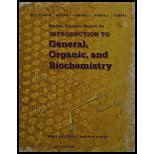
Concept explainers
Interpretation:
The lipoprotein which is responsible for removing the cholesterol deposited in the plaque on arteries needs to be identified.
Concept introduction:
A fat or waxy substance present in all parts of the body is known as cholesterol. It helps in the formation of hormones, cell membranes and vitamin D in the body. There are two sources of cholesterol in the blood (1) food and (2) liver. All the cholesterol in the body is made in liver. Lipoproteins help in the movement of cholesterol and the other fats in the blood. They are like particles spherical in the shape. There are two lipoproteins that are commonly known (1) low density lipoproteins and (2) high density lipoproteins. The low density lipoproteins are also known as bad cholesterol because they contain most of the cholesterol. This contributes in the formation of plaque inside the arteries that can cause heart attack or stroke. To keep the level of LDL low one should avoid food containing saturated fats and extra calories. Exercise can helps in maintaining the LDL level and healthy weight of the body. On the other hand, high density lipoproteins are good cholesterol as they remove the cholesterol from the body. This should be high in the body, this can be done by regular exercise and avoiding saturated fats. A cholesterol level can be checked inside the body. This helps in lowering the risk of heart disease.
Want to see the full answer?
Check out a sample textbook solution
Chapter 21 Solutions
Student Solutions Manual for Bettelheim/Brown/Campbell/Farrell/Torres' Introduction to General, Organic and Biochemistry, 11th
 Introduction to General, Organic and BiochemistryChemistryISBN:9781285869759Author:Frederick A. Bettelheim, William H. Brown, Mary K. Campbell, Shawn O. Farrell, Omar TorresPublisher:Cengage Learning
Introduction to General, Organic and BiochemistryChemistryISBN:9781285869759Author:Frederick A. Bettelheim, William H. Brown, Mary K. Campbell, Shawn O. Farrell, Omar TorresPublisher:Cengage Learning Chemistry for Today: General, Organic, and Bioche...ChemistryISBN:9781305960060Author:Spencer L. Seager, Michael R. Slabaugh, Maren S. HansenPublisher:Cengage Learning
Chemistry for Today: General, Organic, and Bioche...ChemistryISBN:9781305960060Author:Spencer L. Seager, Michael R. Slabaugh, Maren S. HansenPublisher:Cengage Learning General, Organic, and Biological ChemistryChemistryISBN:9781285853918Author:H. Stephen StokerPublisher:Cengage Learning
General, Organic, and Biological ChemistryChemistryISBN:9781285853918Author:H. Stephen StokerPublisher:Cengage Learning Organic And Biological ChemistryChemistryISBN:9781305081079Author:STOKER, H. Stephen (howard Stephen)Publisher:Cengage Learning,
Organic And Biological ChemistryChemistryISBN:9781305081079Author:STOKER, H. Stephen (howard Stephen)Publisher:Cengage Learning,



